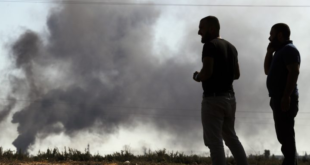HONG KONG (Reuters) – Asian stocks fell on Wednesday, with Japan recording its worst losing streak in 43 years, as climbing oil and food prices exacerbated stagflation fears, increasing the risk investors will capitulate and knock the market even lower.
European stocks were flat to modestly higher, but high oil prices, and a grim warning from British retailer Marks & Spencer on the consumer outlook may cap gains.
The need for stability became paramount as the outlook for corporate earnings, business investment and consumer spending all deteriorated in the face of upward price pressures, supporting government bonds and gold.
Cathay Pacific and M&S, two firms that warned about their bottom lines, were the latest to take a hit as a result of slower growth and high energy costs.
“Inflation is rising globally, and that is probably a bigger scare than the second round of capital writedowns that we’re seeing in U.S. financials,” said Mixo Das, strategist with Lehman Brothers in Hong Kong.
“There’s no indication inflation is peaking,” said Das, who recommended staying invested in sectors that are relatively insulated from external price pressures such as utilities and telecommunications companies.
Japanese stocks, which earlier this year were hailed as the smart buy amid rising global inflation, tumbled on fears that high energy prices will curtail demand for exports from the world’s second-largest economy. The Nikkei share average ended down by 1.3 percent at an 11-week low, having fallen for 10 days in a row — the longest daily losing streak since 1965.
Hong Kong’s Hang Seng index fell 1.5 percent, weighed the most by losses at HSBC Holdings and China Mobile Cathay Pacific was the second-largest decliner in Hong Kong after the company warned of “disappointing” first-half earnings because of expensive jet fuel.
Outside of Japan, shares in the Asia-Pacific region were down 0.1 percent, according to an MSCI index and were within striking distance of lows not seen since mid March.
Another wave of selling could ensue on a convincing move below those lows and a substantial rise in market volatility, as investors dump losing positions even if it means taking a big hit.
“There’s quite an ominous technical pattern that we’re looking at in Asia,” said Lawrence Balanco, technical analyst at CLSA in Hong Kong. “It has been an orderly decline so far, but the capitulation risk is out there.”
Australian shares fell 0.9 percent on Wednesday, inching closer to a 2008 closing low.
STAGFLATION FIXATION
Korean stocks were some of the biggest decliners in the region, with the KOSPI index down 2.7 percent. Shares of consumer technology firm LG Electronics dropped 4.2 percent after dealers said JPMorgan slashed its price target on the stock, citing lackluster wireless handset sales.
The market’s focus remained on how stagflation — the toxic mix of rising inflation and slowing growth — would hurt consumer demand and corporate earnings. Modest gains on Wall Street overnight were largely ignored.
For many investors around the world, the most important event this week is the June U.S. employment report due on Thursday. A larger-than-expected contraction in the U.S. labour market would almost certainly spark fears about less demand for the exports from Asia.
U.S. Treasuries and Japanese government bonds rose as investors fled to relative safety from equity markets.
The benchmark 10-year Treasury note yield which moves in the opposite direction of the price, ticked down to 3.99 percent compared with 4 percent late in New York.
The 10-year Japanese government bond yield slipped 1.5 basis points to 1.655 percent.
The euro extended earlier gains versus the dollar to hit a 2-month high, up 0.25 percent at $1.5825 having hit a 2-month peak of $1.5847
High food and energy prices, the often-cited culprits of the surge in global inflation, showed no sign of letting up.
U.S. soybean prices, a critical import for China, rose to a record high for a third day on concerns about dwindling supply. Meanwhile, corn futures bounced from a two-week low hit on Tuesday, putting upward pressure on prices of everything from ethanol to soft drinks.
U.S. crude prices climbed $1.18 to $142.15 a barrel close to the record $143.67 a barrel hit on Monday, as tensions grew between Israel and the world’s fourth largest oil exporter Iran.
Gold, often used by investors as a hedge against rising inflation, rose to the highest since mid April, at $940.30/941.30 an ounce.
 Eurasia Press & News
Eurasia Press & News



